Double-circuit electric boiler: device, analysis of advantages and disadvantages + what to consider when choosing
If it is not possible to carry gas into the house, it is necessary to solve the problem with autonomous heating and water heating using alternative energy sources. You can install solar generators, heat wood or pellets. However, a double-circuit electric boiler may be the best solution.
In our article, we describe in detail the principle of operation and the types of equipment that process electrical energy into thermal energy. Listed are guidelines that should be taken into account by the future owners of the unit before buying it. Recommendations on economical operation are given.
The content of the article:
The principle of operation of the device
The design of the double-circuit boiler provides for the placement in one device of two heating elements for heating water and a coolant. The system works thanks to the conversion of electric current into thermal energy.
Design features of a double-circuit boiler
To heat the room, a closed-loop heating circuit is connected to the boiler, along which the coolant moves. The second pipeline is designed to supply hot water, which is heated in the built-in storage tank or according to the flow principle.
In the warm season, the heating can be turned off and the boiler can only be used as a boiler.
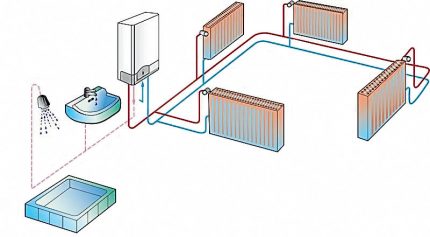
The device consists of the following main elements:
- cases with thermal insulation, input and output fittings;
- a heat exchanger through which the coolant circulates;
- control system and automation unit that allows you to set the temperature parameters and turn off / on the device;
- heating device;
- expansion tank for pressure relief;
- safety valve;
- an air vent (automated or manual) for removing air jams;
- circular pumps for domestic hot water and heating;
- safety groups with temperature sensors and relays.
The principle of operation of the electric boiler is heat exchange: a circular pump pumps water into the tank, which is heated to a certain temperature by a thermocouple and is discharged either to the heating circuit or to the domestic hot water system.
In fact, a dual-circuit electrical appliance, like its gas counterpart, can serve as both a house boiler and a flow heater for water.
Advantages and disadvantages of electrical equipment
Electric heating is an environmentally friendly method of heating, because it does not pollute the air with smoke and soot like a solid fuel boiler, carbon monoxide and other harmful "waste", like gas equipment.
Also feature work electric heating virtually eliminates emergency force majeure during water leakage - if there is no coolant in the system, the equipment automatically turns off.
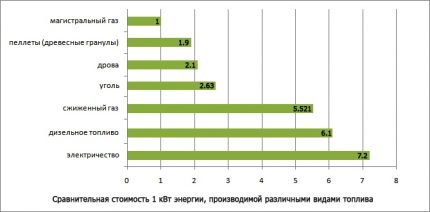
Also, the common advantages of electrical equipment include:
- Easy installation - there is no need to equip a chimney, forced ventilation system, supply a gas pipeline and draw up a bunch of permits, as when installing a gas boiler.
- Safety - the probability of leakage or boiling of an electric boiler is very small, in addition, the design of the device does not provide for the use of an open flame, flammable materials and explosive gas.
- Compact size - An important moment for small rooms. In addition, the device can be installed not only in places specially provided for by the project (like gas equipment), but in any convenient place where it is possible to connect to the mains and heating system.
- Noiselessness - The electric boiler works without vibrations, “exhausts" and other sounds that solid-fuel and gas appliances sin.
- Affordable cost both the device itself and its installation, maintenance.
As for the shortcomings, one of the most significant is the cost of energy consumed. If it is about electric heating and dhw for a large cottage, the amounts will be impressive.
Therefore, it will not be superfluous to make at least an approximate calculation of consumption before buying by analyzing information about the area, water consumption and power of the device. And then decide whether the “sheepskin” is worth the cost.
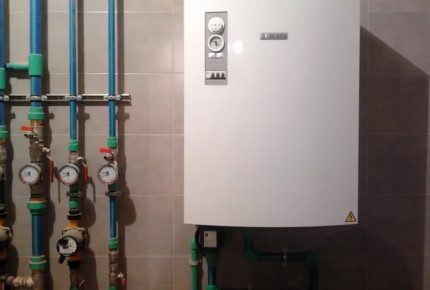
Other cons:
- Energy Dependence - in an area with constant interruptions in electricity, the installation of such a heating device loses its meaning. However, if the outages are random, and are not the norm, the purchase of a generator that stores energy will help to solve the problem.
- Line voltage surges they have a detrimental effect on the sensitive automation of the boiler, so before installing the equipment it is worthwhile to purchase good energy stabilizers.
- Sedimentation. Since running water is used for domestic hot water, the heating elements are gradually covered with scale, which must be removed from the equipment. The solution may be to install filters at the inlet of cold water and regular service.
Also, before you install electric boiler, it is worth to find out if your home network is designed for such a load. For example, an area of 200 squares will require at least 16-20 kW.
And this is only for heating, excluding other electrical appliances.And if in new cottage villages such power is provided by connecting to a three-phase network, then for a summer cottage, usually not more than 10 kW are allocated.
Types of electric boilers
Modern electric boilers are equipped with heaters with a different principle of operation. But at the same time, only appliances with a heating element design can be used for heating and hot water supply.
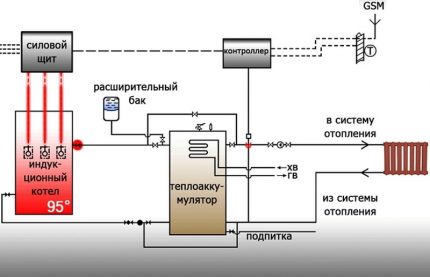
Other types of equipment can be used for domestic hot water only if an indirect heating boiler is connected to the heating circuit.
Electrical appliances with heating elements
In the most common models of electric boilers, heating elements are built in - heating elements, which are made of ceramic or metal, have the form of rods, spirals or a hollow rod curved by an arc, inside which a thread of a certain resistance is placed. They act as "intermediaries", heating up during the passage of electric current and transferring heat to water.
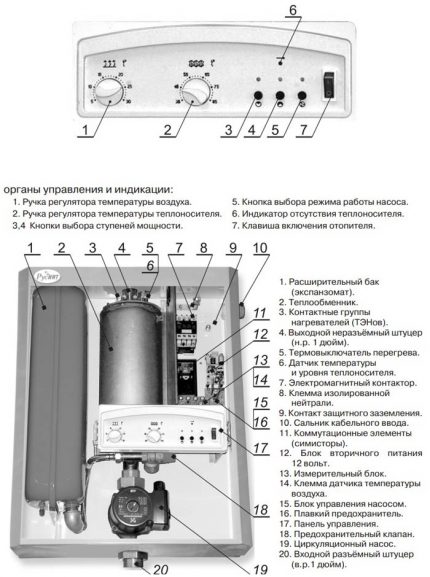
The main disadvantage of the device is the rapid formation of scale on the heating elements, which impairs its performance. For example, when the thickness of the limescale is only 0.5 mm, the efficiency of the device decreases by 10% of the nominal, and at 2 mm - by 35-40%!
As a result, the device heats the water more slowly, so the electricity consumption increases. Therefore, the boiler needs constant cleaning and periodic replacement of failed heating elements.
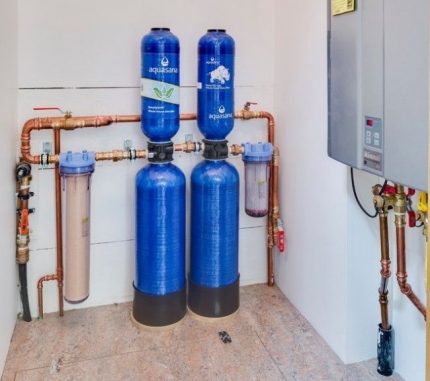
In addition, boilers with heating elements require regular maintenance, because we are talking about the safe use of equipment. The heating element gradually wears out and may burn out.
If this happens with the depressurization of the case - another half the trouble. In this case, the heated nichrome simply crumbles from contact with water and does not pose a danger to humans. But if the disconnected element remains in the undamaged case and continues to work, the entire metal case due to the conductor-water will be energized.
Induction heating equipment
The operation of the induction boiler is based on magnetic induction, which allows you to convert electricity to thermal energy. Inside the housing there is a primary circuit with an inductive coil, which, when voltage is applied, creates an alternating magnetic field.
As a result, the so-called Foucault currents (or eddy currents) arise, which heat the metal, and it transfers its heat to the circulating carrier.
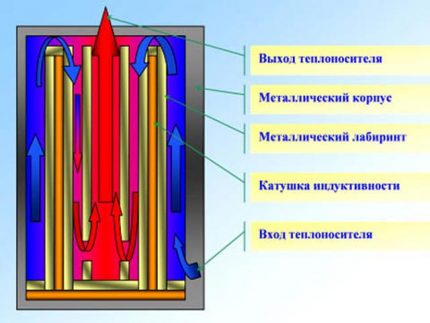
Advantages of induction boilers compared to heating appliances:
- The highest level of efficiency is 98-99%.
- Large heating area and, consequently, faster heat transfer.
- Scale does not form on the heating element.
- Completely autonomous, and do not require service.
- In addition to water, oil and oil can be used as a heat carrier.
The main disadvantage of such devices is the high price and the need to connect indirect heating boiler or storage tank to provide home with hot water.Therefore, in spite of a number of advantages of induction equipment, double-circuit heating elements boilers firmly hold the palm of consumer demand leadership.
Boilers with electrode heaters
The operation of the electrode boiler is based on high thermal conductivity near water. Inside the case there are negative and plus electrodes that generate electric current, circulates between them coolant.
Heating occurs due to the energy that is released during the splitting of molecules into charged ions, and their movement to the electrode of the corresponding polarity. Due to this, heating of water in the boiler chamber occurs almost instantly.
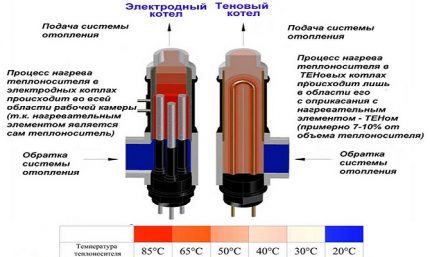
Advantages of electrode boilers in comparison with TEN devices:
- Heats water 10 times faster.
- Spend 20-30% less electricity.
- They have compact dimensions even with high productivity (most often, models are presented in wall-mounted design).
- Do not fail with power surges.
But due to significant shortcomings, electrode boilers have not yet become widespread. They are mainly used for heating, but it is possible to organize a second circuit for hot water supply provided that the system is equipped with an indirect heating boiler.
These devices are very demanding on the composition of the liquid, which is a coolant. Normal tap water is excluded, it is recommended to use a special liquid with a balanced salt composition. In addition, the electrodes gradually dissolve during operation and require replacement.
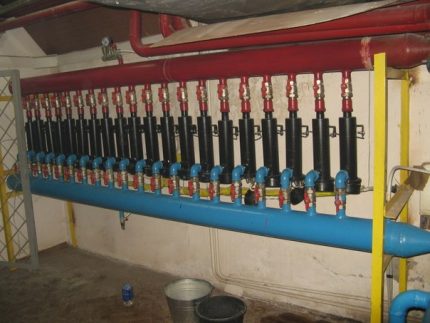
For safe use, the electrode boiler is recommended to be equipped with an additional set of automation, which is sold separately and often costs more than the device itself. First of all, it is a circulation pump and an electronic temperature controller that controls the heating temperature.
A current controller is also needed, regulating the current strength, with the ability to turn off the equipment in order to prevent boiling water.
What to look for when buying?
When you figured out what kind of device you want to buy, it's time to think about its size and technical parameters.
Most often, electric boilers are installed in the kitchen, but you can also equip a mini-boiler room, which allows you to hide unattractive communications and additional equipment (storage tank, indirect heating boiler, etc.).
Selecting a device by installation method
Regardless of the type of construction, all double-circuit boilers can be divided into two large groups - wall and floor. Dimensions and model selection directly depend on the area that you need to heat, and even on the amount of free space for the device itself.
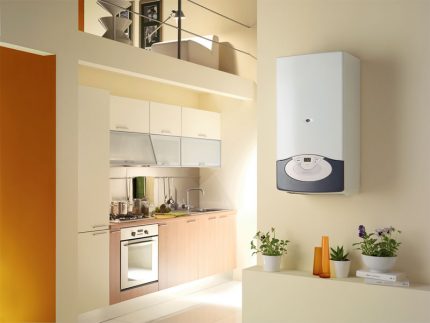
Attachments are designed to heat relatively small areas - up to 100 m2, so they are most often installed in apartments or small country houses. They are mounted on special brackets to any vertical surface that can withstand such a load.
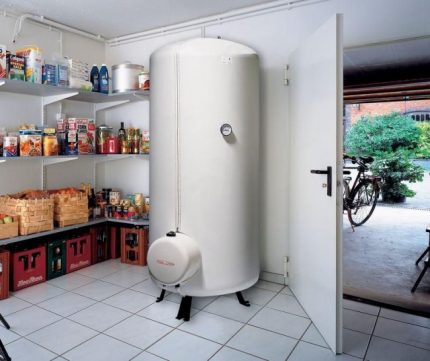
If the cottage’s squared exceeds 200 m2, can equip a boiler room with several electric boilers or use additional sources of heating - solid fuel equipment or solar panels.
Calculation of the required power
The easiest way is to divide the heated area by 10. It is believed that when heated 10 m2 1 kW will be spent, but the resulting figure will be very conditional, because such a calculation makes sense only for rooms with a height of not more than 3 meters.
In addition, the cost of heat largely depends on the presence of insulation, the quality of the windows and their sizes, the climatic features of the area and the materials used in the construction of the house.
If the house has high ceilings, you must first determine the volume of the room (multiply the area by height). Then, calculate the required power based on the calculation that 1 Watt will require 35 watts.
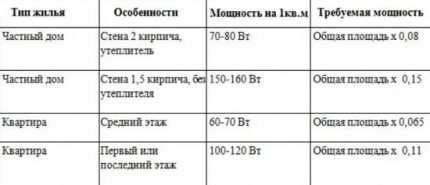
To the result you need to add a "margin":
- 10% - with a large area of glazing (panoramic windows, porch, etc.).
- 15% - in the absence of house insulation.
- 10-15% - for areas with cold winters.
- 20% - on the additional load during the operation of hot water in the instantaneous heating mode.
When calculating the required power for boilers with a built-in storage, you need to focus on the data specified by the manufacturer in the technical documentation.
The method of its power depends on the technical parameters of the boiler. Devices up to 10 kW can be connected to a conventional 220 V network, and more powerful boilers can be connected to a three-phase network (moreover, this may require permission from local power networks if a 380V line is not connected to the house).
Other important nuances
By the principle of heating water, double-circuit electric boilers can be divided into flowing and storage. The first ones are a good option for a small house and family, he will be able to calmly maintain 1-2 water outlets in addition to heating. But despite the compactness and comfort in operation, the “2 in 1” device has a significant drawback - a high load on the power grid.
And here storage unit It takes up much more space due to the additional tank in which a stock of hot water is stored. The advantage of this type of equipment is that it can supply large quantities of water and can save up to 10% on electricity, since it does not spend energy on constant heating, but only maintains its temperature.
Thanks to the insulating casing, the heat loss of water in the tank per hour will be no more than 0.5 degrees. The technical passport of the device intended for connection to the hot water supply system should indicate its throughput - temperature minimum and maximum, water volume and the necessary time for heating it.
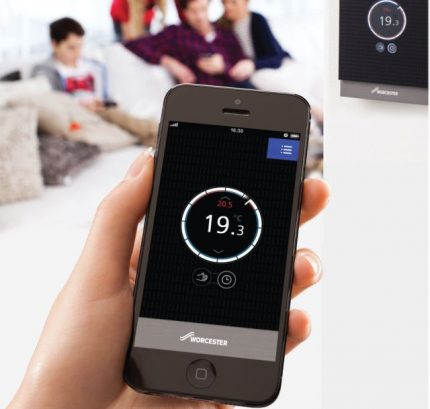
Additionally, the boiler can be equipped with:
- Automation unit for remote control from a remote control or via a network.
- Protection against freezing, which will allow maintaining the minimum temperature in the system, which is important for country houses and country houses where there are no permanent residents.
- Sensors that track weather changes turn on the device when the temperature drops and turn it off during sundial.
- Equipment that reduces the temperature of the water to connect to floor heating system.
- Sensors with the ability to program the microclimate in the entire room or individual rooms at their discretion.
Of course, “bonuses” from the manufacturer increase the cost of the device, but with their help it is much more convenient to operate the boiler.
Ways to save during operation
To reduce the cost of electricity when using an electric boiler as a heating device and a water heater, it is necessary to reduce the total heat loss at home.
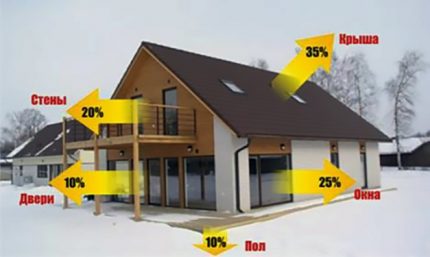
Other savings options:
- An additional connection or separate devices operating on alternative energy (solar panels, wind generators, wood-burning fireplace) will significantly reduce electricity consumption.
- A multitariff meter will allow you to pay less for night heating, and for the period of morning and evening "rush hours" the device can be turned off (the most expensive is the electricity spent between 8.00 - 11.00 and 20.00 - 22.00). And if you supplement the system with an external heat accumulator, you can accumulate nightly “cheap” energy in order to spend it during the day.
- A recuperator in the ventilation system will help maintain heated air inside the house.
- A weekly programmer will collect data on the operation of the system for a specified period of time in order to choose the most comfortable and economical mode of operation with minimal energy consumption.
- Room thermostats will monitor changes in the microclimate of the house and transmit data to a sensor built into the boiler, which will turn off / turn on the heating, protecting it from overheating of air and excess heat loss.
With the proper organization of the electric boiler, you can reduce energy consumption and associated costs up to 40%.
Introduces energy-saving options for heating suburban property next article, parsing in detail this very interesting question.
Conclusions and useful video on the topic
We recommend that you familiarize yourself with a selection of reviews and practical tips on the use of electric boilers of various designs for heating and hot water supply at home.
The nuances of electric heating - boilers and other electric heating devices, calculation of equipment power and costs for the heating season:
Although double-circuit electric boilers seem quite comfortable to use, before you go shopping, calculate the cost of electricity for the cold season or consult a heating engineer.
Perhaps they will advise you on a more economical system with a single-circuit boiler with an indirect heating boiler or design combined heating, where the "gluttony" of the electrical appliance will be compensated by additional energy sources.
Please write comments in the block below. Tell us what has become a decisive argument for you in choosing a double-circuit boiler model. Share useful information that will be useful to site visitors, ask questions.

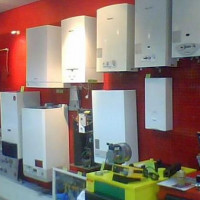 What is better double-circuit or single-circuit gas boiler: features of the device and operation
What is better double-circuit or single-circuit gas boiler: features of the device and operation 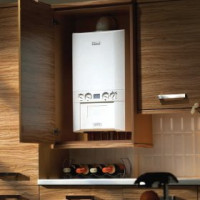 How to choose a gas wall-mounted double-circuit boiler: what to look at + what the market offers
How to choose a gas wall-mounted double-circuit boiler: what to look at + what the market offers 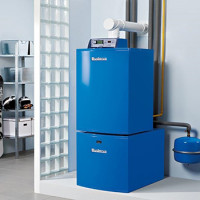 How to choose a dual-circuit floor gas boiler: what to look at before buying?
How to choose a dual-circuit floor gas boiler: what to look at before buying?  Which is better and more profitable - a gas or electric boiler? Arguments for choosing the most practical option
Which is better and more profitable - a gas or electric boiler? Arguments for choosing the most practical option 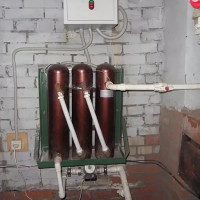 Induction heating boilers: types, an overview of the advantages and disadvantages of how to choose a good model
Induction heating boilers: types, an overview of the advantages and disadvantages of how to choose a good model 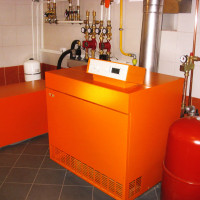 Gas boiler with an electric generator: device, principle of operation, an overview of the best brands
Gas boiler with an electric generator: device, principle of operation, an overview of the best brands  How much does it cost to connect gas to a private house: the price of organizing gas supply
How much does it cost to connect gas to a private house: the price of organizing gas supply  The best washing machines with dryer: model rating and customer tips
The best washing machines with dryer: model rating and customer tips  What is the color temperature of light and the nuances of choosing the temperature of the lamps to suit your needs
What is the color temperature of light and the nuances of choosing the temperature of the lamps to suit your needs  Replacement of a geyser in an apartment: replacement paperwork + basic norms and requirements
Replacement of a geyser in an apartment: replacement paperwork + basic norms and requirements
We ventured to buy a double-circuit electric boiler in the house for my grandmother, she lives in the village. Nobody will have gas there and will not soon, and spending it only for themselves will result in a huge amount. And it’s already physically difficult to heat the furnace. The advantages of such a device are appreciated, it gives both heat and hot water.The only thing is that he consumes a lot of electricity, but his grandmother has privileges, so for her this is the best option.
Although gas was carried out in our house, they decided to heat it with electricity anyway. We have a double-circuit boiler. Conveniently, when you do not need heating, you can simply turn it off and use only hot water. It is small and compact, hung on the wall and forgot. But what is inconvenient is that the boiler depends on electricity, and if the light is turned off, then there will be no heat. And in winter the house cools down quickly.